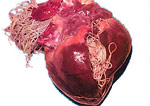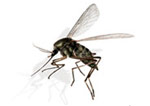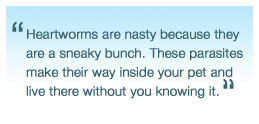Pet Enemy Files: The Heartworm Life Cycle and Transmission
If you think that fleas are all you have to worry about, think again. Believe it or not, as nasty as fleas are, they are not as foul and disgusting as heartworms.
Heartworms are nasty because they are a sneaky bunch. These parasites make their way inside your pet and live there without you knowing it. While inside your pet, they grow and multiply nonstop and cause heart failure and serious damage to other organs.
Heartworms, or
Dirofilaria immitis, are creepy, serpent-like monsters that are close relatives of roundworms. They usually affect dogs, but they may also infest cats, ferrets, sea lions, and in some cases, even humans. Heartworms are transmitted from one animal to another through mosquitoes.
How It All Begins

An animal that is infested with heartworms may contain hundreds to thousands of baby heartworms called
microfilariae in its bloodstream. These microfilariae are microscopic and can live inside an animal for up to three years. However, not all these baby heartworms get to develop into adults. This is because the microfilariae need to be ingested by mosquitoes for them to develop into larvae; otherwise they remain in the animal's bloodstream and eventually die. In other words, mosquitoes play a major part in the heartworm life cycle.
Inside the Mosquito

Microfilariae are ingested by mosquitoes when they feed on the blood of an infected animal. Once ingested, these
first-stage larvae (L1) or baby heartworms make their way into the mosquito's stomach then to its kidney. There, they molt and change into
second-stage larvae (L2). In a few days, they start to develop their internal organs, increase in length and become
third-stage larvae (L3) or miniature adult heartworms. This is called the
infective stage, wherein they leave the mosquito's kidney and travel to its
proboscis or mouth where the third-stage larvae become ready for transmission. In this entire process, the mosquito serves as a temporary host for the heartworm larvae.
Into Another Animal

The heartworm larvae find their way into a new host when the mosquito carrying them bites another animal. When the mosquito bites the new host, the heartworm larvae are deposited into the animal's skin, where they stay for several days. Then, they burrow deeper into the animal and settle in its tissues where they linger for a couple of months. While inside the animal's tissues, they continue to develop until they become
fourth-stage larvae (L4) or young adult heartworms.
Once they become young adults, they leave the tissues and enter the animal's bloodstream. They circulate in the bloodstream and eventually end up in the heart. There, they continue to grow until they become full-fledged heartworms. Inside the animal's heart, they mate to produce microfilariae. Then, the cycle starts all over again.
What to Do

The heartworm life cycle takes about six months, or an equivalent of a normal winter. This is why most veterinarians prefer testing your pet for heartworms before spring. As with fleas, transmission of these parasites is more common during warm months when mosquitoes are active, which is usually from late spring to early fall. Heartworms are also prevalent in places where the weather is warm. In the United States, heartworms are fairly common in southeastern and midwestern areas.
However, even if you don't live in places where there is warm weather, it doesn't mean that your pet is no longer susceptible to heartworms. Dogs are especially more susceptible regardless of age, size and breed. For this reason, it's important to keep your dog on heartworm preventatives all year 'round. Getting them regularly tested for heartworms also helps in making sure that none of these parasites sneak their way inside your pet. You don't want heartworms to pull a fast one on you, do you?

 Microfilariae are ingested by mosquitoes when they feed on the blood of an infected animal. Once ingested, these first-stage larvae (L1) or baby heartworms make their way into the mosquito's stomach then to its kidney. There, they molt and change into second-stage larvae (L2). In a few days, they start to develop their internal organs, increase in length and become third-stage larvae (L3) or miniature adult heartworms. This is called the infective stage, wherein they leave the mosquito's kidney and travel to its proboscis or mouth where the third-stage larvae become ready for transmission. In this entire process, the mosquito serves as a temporary host for the heartworm larvae.
Into Another Animal
Microfilariae are ingested by mosquitoes when they feed on the blood of an infected animal. Once ingested, these first-stage larvae (L1) or baby heartworms make their way into the mosquito's stomach then to its kidney. There, they molt and change into second-stage larvae (L2). In a few days, they start to develop their internal organs, increase in length and become third-stage larvae (L3) or miniature adult heartworms. This is called the infective stage, wherein they leave the mosquito's kidney and travel to its proboscis or mouth where the third-stage larvae become ready for transmission. In this entire process, the mosquito serves as a temporary host for the heartworm larvae.
Into Another Animal
 The heartworm larvae find their way into a new host when the mosquito carrying them bites another animal. When the mosquito bites the new host, the heartworm larvae are deposited into the animal's skin, where they stay for several days. Then, they burrow deeper into the animal and settle in its tissues where they linger for a couple of months. While inside the animal's tissues, they continue to develop until they become fourth-stage larvae (L4) or young adult heartworms.
Once they become young adults, they leave the tissues and enter the animal's bloodstream. They circulate in the bloodstream and eventually end up in the heart. There, they continue to grow until they become full-fledged heartworms. Inside the animal's heart, they mate to produce microfilariae. Then, the cycle starts all over again.
What to Do
The heartworm larvae find their way into a new host when the mosquito carrying them bites another animal. When the mosquito bites the new host, the heartworm larvae are deposited into the animal's skin, where they stay for several days. Then, they burrow deeper into the animal and settle in its tissues where they linger for a couple of months. While inside the animal's tissues, they continue to develop until they become fourth-stage larvae (L4) or young adult heartworms.
Once they become young adults, they leave the tissues and enter the animal's bloodstream. They circulate in the bloodstream and eventually end up in the heart. There, they continue to grow until they become full-fledged heartworms. Inside the animal's heart, they mate to produce microfilariae. Then, the cycle starts all over again.
What to Do
 The heartworm life cycle takes about six months, or an equivalent of a normal winter. This is why most veterinarians prefer testing your pet for heartworms before spring. As with fleas, transmission of these parasites is more common during warm months when mosquitoes are active, which is usually from late spring to early fall. Heartworms are also prevalent in places where the weather is warm. In the United States, heartworms are fairly common in southeastern and midwestern areas.
However, even if you don't live in places where there is warm weather, it doesn't mean that your pet is no longer susceptible to heartworms. Dogs are especially more susceptible regardless of age, size and breed. For this reason, it's important to keep your dog on heartworm preventatives all year 'round. Getting them regularly tested for heartworms also helps in making sure that none of these parasites sneak their way inside your pet. You don't want heartworms to pull a fast one on you, do you?
The heartworm life cycle takes about six months, or an equivalent of a normal winter. This is why most veterinarians prefer testing your pet for heartworms before spring. As with fleas, transmission of these parasites is more common during warm months when mosquitoes are active, which is usually from late spring to early fall. Heartworms are also prevalent in places where the weather is warm. In the United States, heartworms are fairly common in southeastern and midwestern areas.
However, even if you don't live in places where there is warm weather, it doesn't mean that your pet is no longer susceptible to heartworms. Dogs are especially more susceptible regardless of age, size and breed. For this reason, it's important to keep your dog on heartworm preventatives all year 'round. Getting them regularly tested for heartworms also helps in making sure that none of these parasites sneak their way inside your pet. You don't want heartworms to pull a fast one on you, do you?